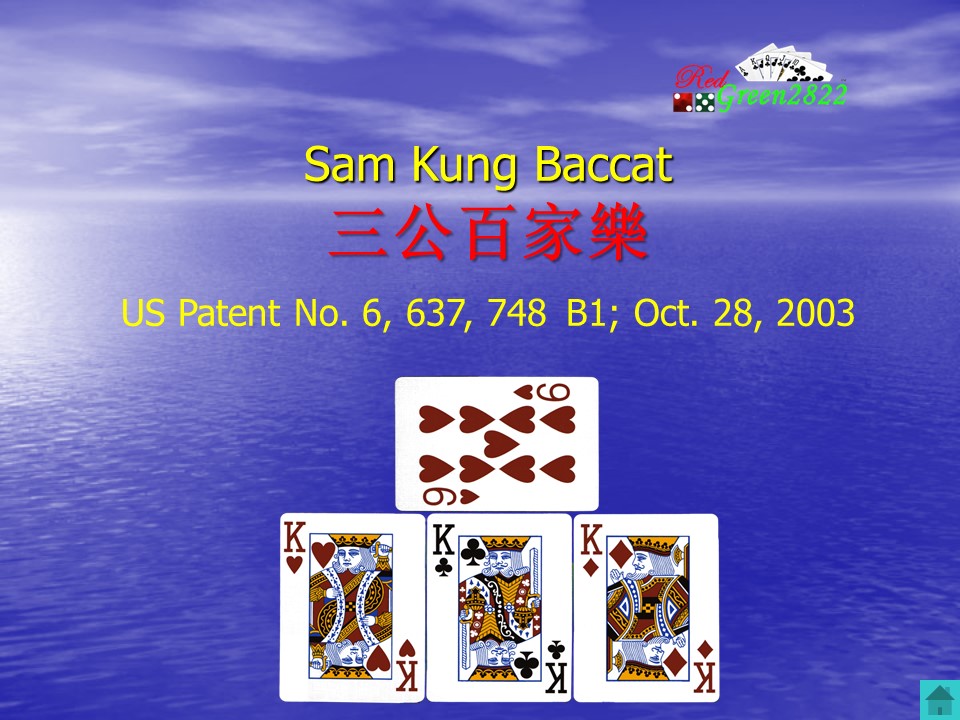Sam Kung Baccarat
三公百家樂
Table Sign

Table Layout
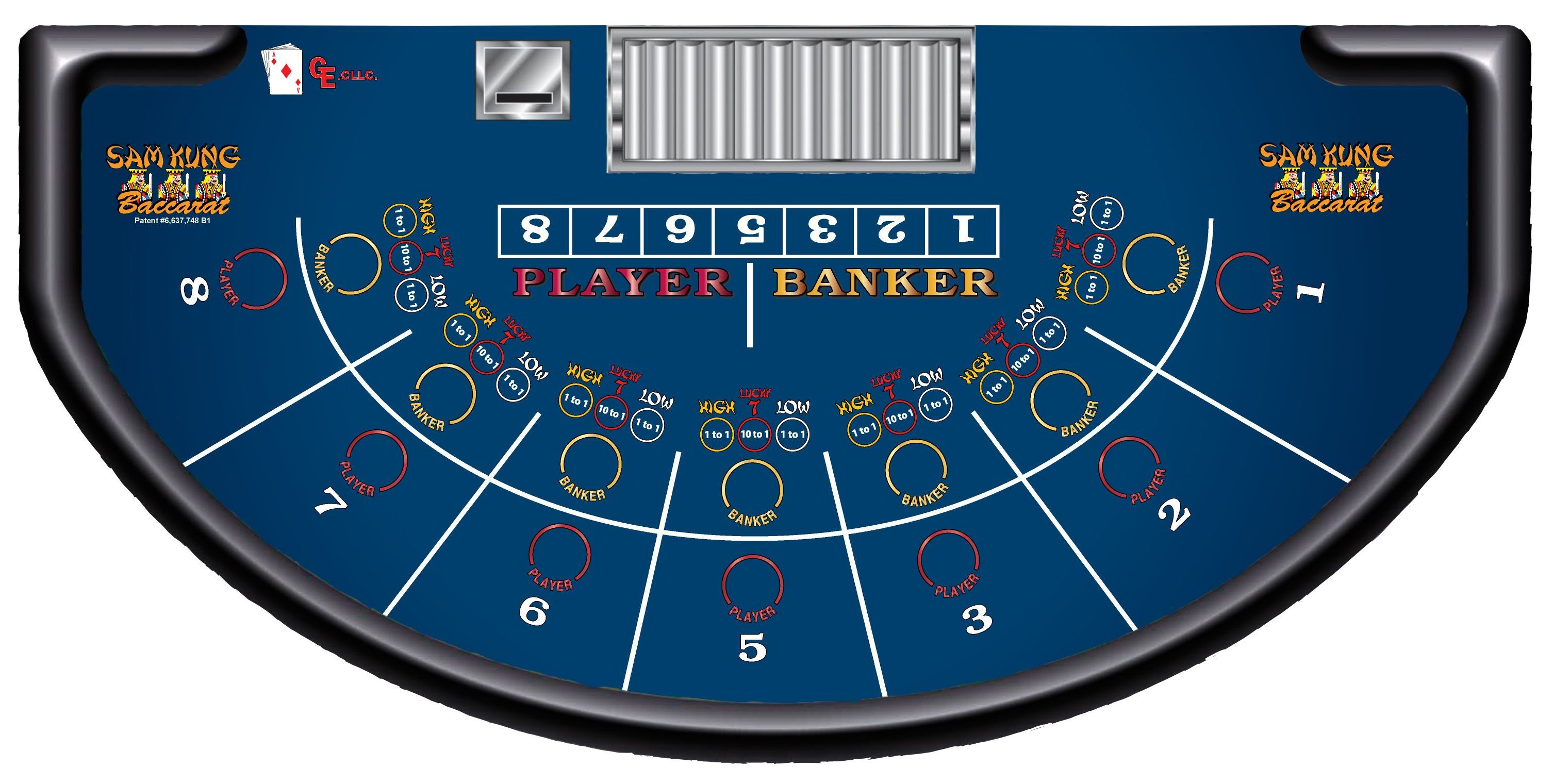
Rack Card
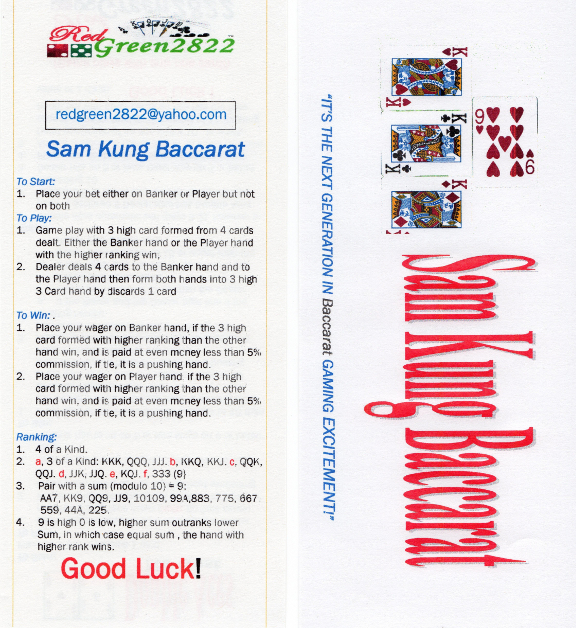
PLAYING RULES
House Dealer deals 4 cards to the Player hand and to the Bank hand (1 in turn) Dealer will hand the 4th card of both hands to the higher better of that hand, when the 4th card was returned, the Dealer sets it in House way (Dealer will discard 1 card from both hands to form a high 3 Card hand), the discarded card will place above of the 3 card of both hands to prove both hands are setting correctly. The House Dealer will compare both hands, the higher ranking hand wins. House charges (5% commission House advantage 2.0%, if charge 2% commission House advantage 0.8%) on both winning hands (the Player and the Banker hands). If there is a tie, it is considered a pushing hand. If either the Player hand or the Banker hand has a 4 of a kind, it is an automatic winning hand, if both hands have a 4 of a kind, the higher ranking is a winner.
Ranking of Hands (in descending order)
- Four of a kind
- Special hands (in descending order)
- Three of a kind face cards:
- K K K
- Q Q Q
- J J J
- Pair of face cards with an unmatched face card:
- K K Q
- K K J
- Q Q K
- Q Q J
- J J K
- J J Q
- Three unmatched face cards: K Q J
- Three of a kind with a sum = 9: 3 3 3
- Pair with a sum (modulo 10) = 9:
- A A 7
- K K 9
- Q Q 9
- J J 9
- 10 10 9
- 9 9 A
- 8 8 3
- 7 7 5
- 6 6 7
- 5 5 9
- 4 4 A
- 2 2 5
- Three of a kind face cards:
- Sum (modulo 10) of the three cards ranked from highest sum to lowest sum with A = 1, K = Q = J = 0, and all other cards equal to their face value. For example, 3 6 j would have a sum (modulo 10) of 9, which would have a higher ranking than a hand of 8 5 9 with a sum (modulo 10) of 2.
A bet must be made prior to the dealing of any cards. Each player and the dealer will then receive four cards face down.
If the four cards are four of a kind, then the hand has one of the highest ranks. Otherwise, all players and the dealer should keep the best three of their four cards and discard the one that they do not want. The three cards that are kept will be evaluated as follows:
Comparison
- Four of a kind outranks all other hands except a higher ranking four of a kind.
- A special hand outranks all other hands except a four of a kind or a higher ranking special hand.
- Higher sum outranks lower sum, in which case equal sum, the hand with higher rank wins.
- Examples:
- 10 A 8 = 9 outranks A K 7 = 8
- K Q 9 = 9 but outranks by 2 2 5 = 9
- Examples:
HiLow BLACKJACK ANALYSIS
ALSO SAM KUNG BACCARAT HiLow SIDE BET
HiLow Blackjack (Sam Kung HiLow side bet) is regular blackjack with optional side bets. It can be played with one to eight decks of cards.
In addition to the regular blackjack bet, the player has the option to place a bet in a “HiLow” betting area before any cards are dealt. There are three betting circles in the HiLow betting area: the High bet, the Low bet and the 7 bet. All three bets are based on the dealer’s up card. The player has the option of making any one, any two or all of the three bets.
A bet on the High wins even money if the dealer’s up card is any 2, 4, 6, 9, Jack or King. A bet on the Low wins even money if the dealer’s up card is any A, 3, 5, 8, 10 or Queen. A bet on the 7 wins 10 to 1 if the dealer’s up card is 7.
Once the HiLow bets have been settled by the dealer, the game resumes as regular blackjack.
Mathematical Anaylsis
There are thirteen ranks of cards in a deck.
Six out of the thirteen ranks of cards are High cards (2, 4, 6, 9, J or K), so the probability of the dealer up card being a High card is 6/13. The house advantage is 7/13 – (6/13 x 1) = 1/13 = 7.69%.
Six out of the thirteen ranks of cards are Low cards (A, 3, 5, 8, 10 or Q), so the probability of the dealer up card being a Low card is 6/13. The house advantage is 7/13 – (6/13 x 1) = 1/13 = 7.69%.
One out of the thirteen ranks of cards is 7, so the probability of the dealer up card being a 7 is 1/13. The house advantage is 12/13 – (1/13 x 10) = 2/13 = 15.38%.
The probabilities and house advantages for the three bets are summarized below:
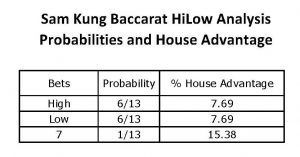
If the player places both the High bet and the 7 bet, the house advantage (HA) can be computed as follows:
HA = (7.69% x B1 + 15.38% x B2) / (B1 + B2)
where B1 is the amount of the High bet and B2 the amount of the 7 bet.
If the player places both the Low bet and the 7 bet, the house advantage can be computed as above.
Presented by: Stanley Ko
BetWiser Games, LLC – PO Box 82225 – Las Vegas, NV 89180 – (702) 258-9685
July 12, 2010
BAI CAO ANALYSIS
Also Sam Kung Baccarat
Bai Cao is a variation of a card game that originated in China. It is played with seven standard decks of 52 cards on a Blackjack sized table with up to 7 players against the dealer.
Rules of Play
A bet must be made prior to the dealing of any cards. Each player and the dealer will then receive four cards face down.
If the four cards are four of a kind, then the hand has one of the highest ranks. Otherwise, all players and the dealer should keep the best three of their four cards and discard the one that they do not want. The three cards that are kept will be evaluated as follows:
Card and Hand Values
All cards have a point value. Face cards and Tens count as 0. Aces count as 1. All other cards count as their face value.
All hands have a point value. With the exceptions that will be shown in the ranking system below, the point value of a hand is calculated by adding all the points of the three cards together. If the sum exceeds 9, then only the rightmost digit of the sum is used. This Modulo-10 point count system is the same as Baccarat. The highest point total is nine. The lowest ranked hand is zero. Some hand examples are given below:
Queen, 5 and 4 makes a hand total of 9 points.
King, Queen and 10 makes a hand total of 0 point.
3, 9 and 10 makes a hand total of 2 points.
Ranking System
The ranking system is shown below, from highest to lowest:
- 4 of a Kind (4 Aces is the highest, 4 Kings the second highest and 4 2’s the lowest)
- K K K
- Q Q Q
- J J J
- K K Q
- K K J
- Q Q K
- Q Q J
- J J K
- J J Q
- Three face cards – K Q J
- 3 3 3
- 9 Points down to 0 point
The bet is played against the dealer. The object is to have a higher point value than the dealer.
Whoever has the higher rank wins. The bet pays 1 to 1 less a 5% commission charged on any player winning hand.
Mathematical Analysis
There are C364,4 x C360,4 = 719,469,751 * 688,235,310 ways to deal four cards to the player and then four cards to the dealer.
The player and dealer will beat each other 40.13% of the time and tie 19.74% of the time.
The house advantage is 40.1278% – 40.1278% x 0.95 = 2.0064%.
A computer program was written to determine the probability distribution and the house advantage as follows:
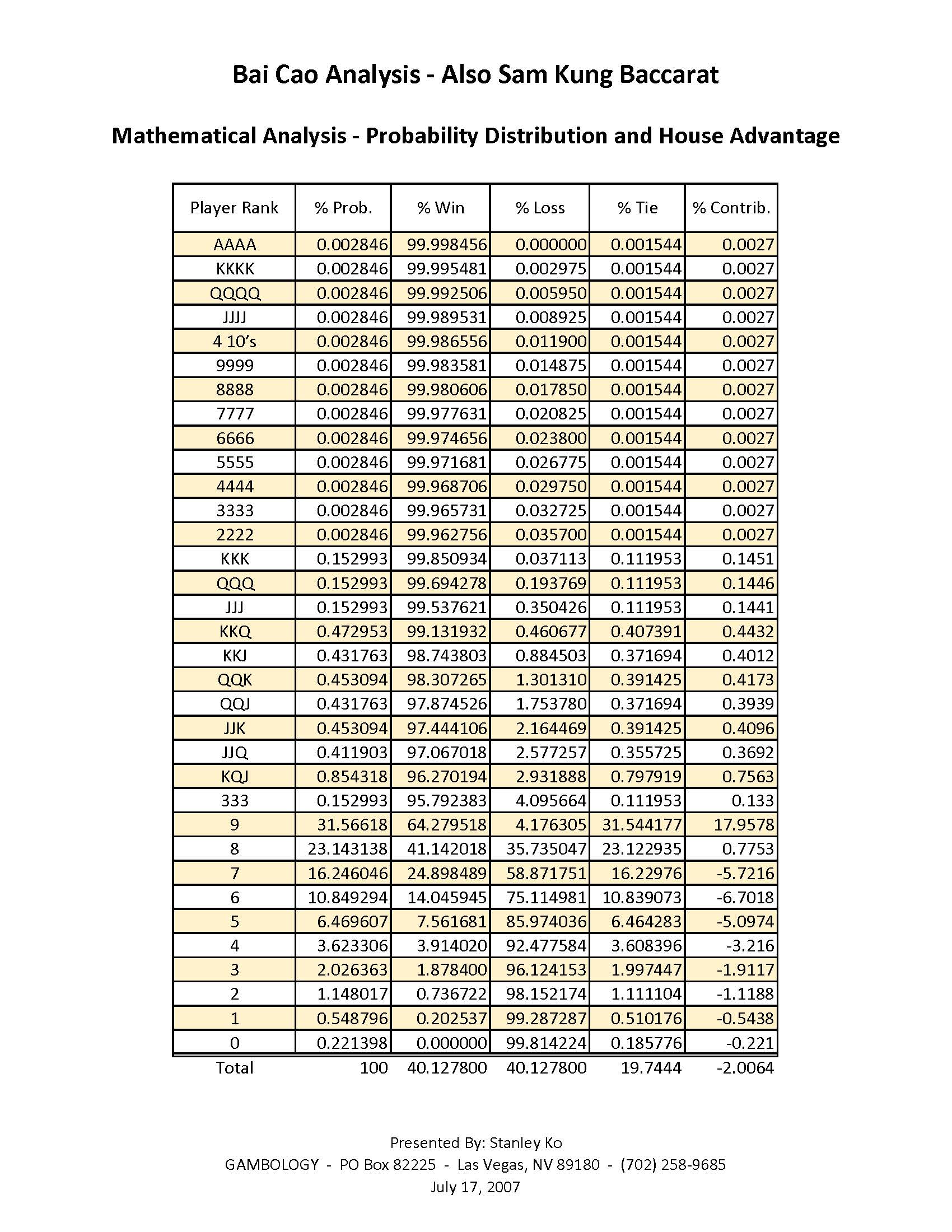
Presented By: Stanley Ko
GAMBOLOGY – PO Box 82225 – Las Vegas, NV 89180 – (702) 258-9685
July 17, 2007
